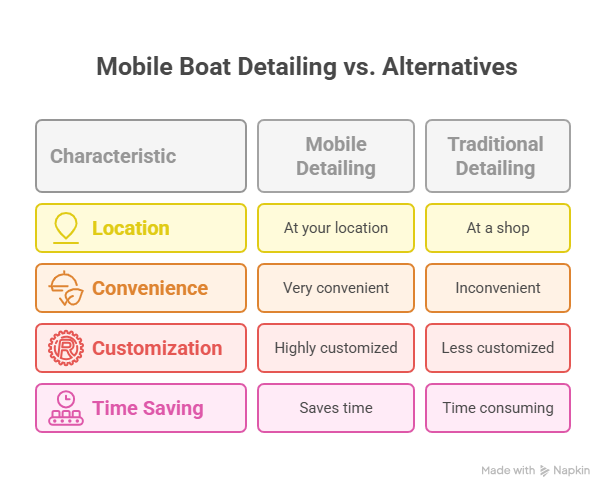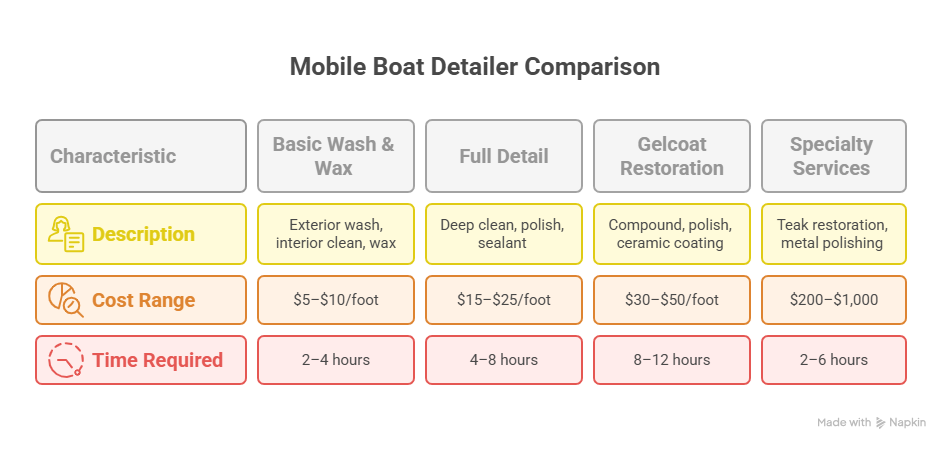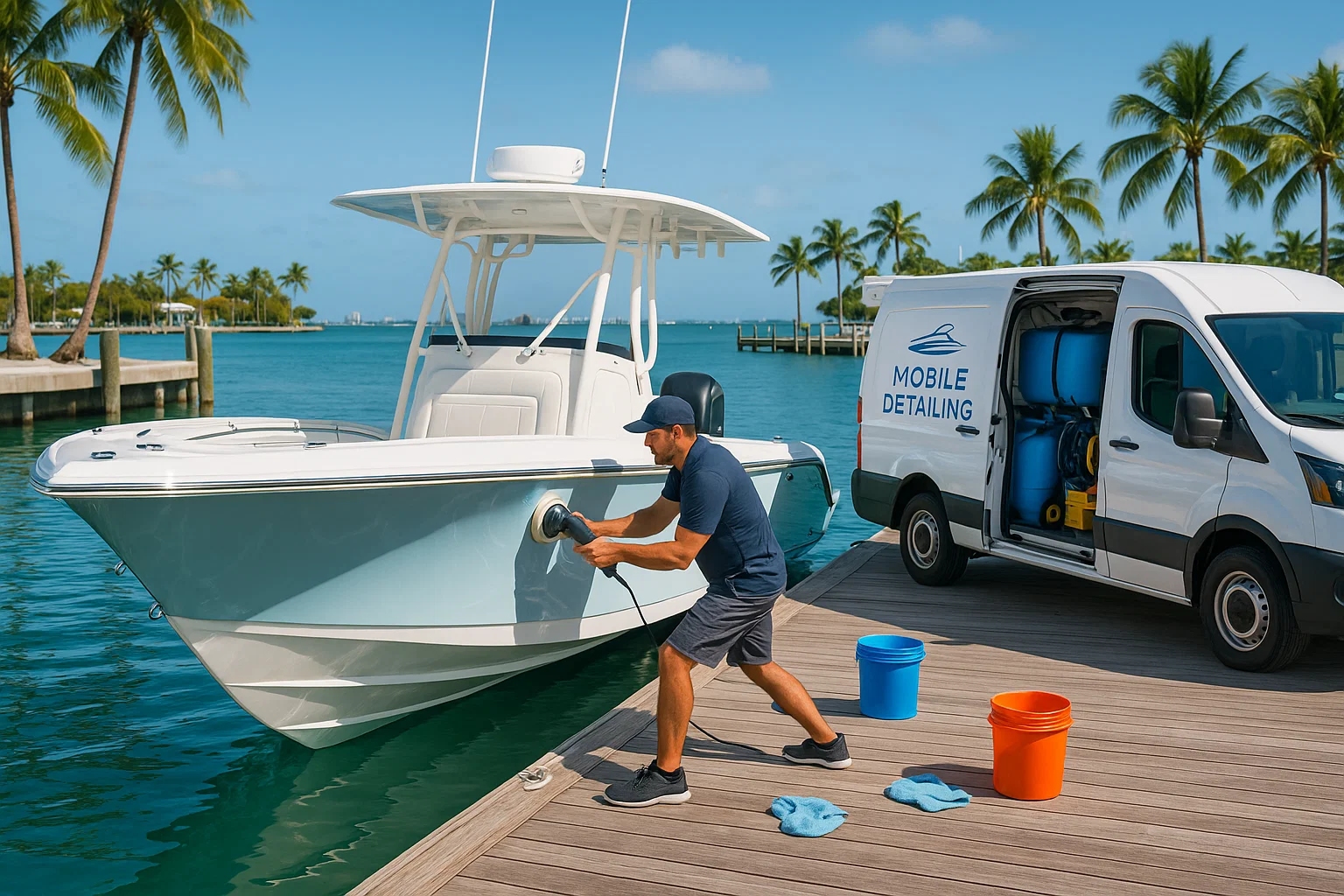Mobile Boat Detailing: 15 Years of Cleaning, Restoring, and Protecting Boats
I’ve been detailing boats in South Florida for 15 years, from sleek center consoles to weathered yachts, mostly around Miami and Fort Lauderdale. Last June, a client named Javier at Dinner Key Marina called me in a panic—his 2021 Sea Ray 350 had a chalky gelcoat and waterline stains that made it look a decade older. I brought my mobile unit, compounded the hull, and applied a ceramic coating—$1,200 later, it gleamed like new. Mobile boat detailing isn’t just about making your boat pretty; it’s about protecting your investment from sun and salt. Here’s my take on why it’s a game-changer, what to expect, and how to pick the right pro.
Table of Contents
Why Mobile Boat Detailing Saves Time and Money
Dragging your boat to a shop is a hassle—trailers, traffic, wasted weekends. Mobile detailing flips that script, bringing the service to you. I’ve cleaned boats at marinas, driveways, and storage units across South Florida, and it’s a lifesaver for busy owners.
What Makes Mobile Detailing So Convenient?
Picture this: you’re at Bahia Mar, sipping coffee, while I roll up with my van—water, power, and all my gear ready to go. No towing, no waiting. I detailed a Grady-White 208 at Stiltsville last summer in under three hours—owner didn’t lift a finger. Mobile pros work at your dock, marina, or home, on your schedule. You can point out specific issues, like mildew on seats or rust on railings, and we’ll tailor the job right there. It’s not just convenient; it’s customized.
Why Is Detailing Key to Protecting Your Boat?
Saltwater and sun are brutal in Miami. Without proper care, your gelcoat oxidizes, vinyl cracks, and resale value tanks. I’ve seen boats lose $10,000 in value from neglected gelcoats—fixable with a $1,500 detail. Professional detailing uses marine-grade products to shield against UV rays and salt corrosion. Last month, I caught early-stage oxidation on a client’s Boston Whaler at Key Biscayne—fixed it before it became a $3,000 repair. Regular detailing keeps your boat market-ready and water-ready.
What Does Professional Mobile Boat Detailing Include?
Detailing isn’t just a wash—it’s a multi-step process to clean, restore, and protect. Think of it as a full reset for your boat, inside and out. Here’s how I break it down.
How Do You Deep Clean a Boat?
A good detail starts with a thorough cleaning to prep the surfaces. I use marine shampoos for vinyl and upholstery, scrubbing every crevice—consoles, cupholders, even teak accents. For the hull, it’s a hand wash followed by specialized cleaners for waterline stains and rust. Last July, a client’s Bayliner 285 at Coconut Grove had algae buildup so bad it took two rounds of citric acid cleaner—$200 extra, but worth it. This step ensures the boat’s ready for restoration.
What’s Involved in Gelcoat Restoration?
Restoring a faded gelcoat is where the magic happens. It’s a three-step process I’ve honed over years:
- Compounding: I use a dual-action polisher with abrasive compounds to remove oxidation and light scratches. On Javier’s Sea Ray, it took off a chalky layer in four hours.
- Polishing: A finer polish smooths the surface for a mirror-like gloss—makes the boat pop.
- Protecting: I apply a marine wax or polymer sealant for UV and salt resistance. Wax lasts 3–6 months; sealants hit 12 months.
Are Ceramic Coatings Worth It?
For top-tier protection, ceramic coatings beat wax hands-down. They form a glass-like shell, repelling water and grime for 2–3 years. I coated a client’s Pursuit 3070 last spring for $2,000—pricey, but cleanings now take half the time. Ceramics resist UV damage better than wax, keeping the gelcoat vibrant. If you boat often in Miami’s sun, it’s a no-brainer.

How Do I Choose the Right Mobile Boat Detailer?
Picking a detailer is about trust and expertise. I’ve seen too many owners burned by amateurs who skip steps or damage gelcoats. Here’s how I’d vet a pro.
What Services Should a Detailer Offer?
Know your boat’s needs before you call. Need a quick wash or a full restoration? I ask clients to walk their boat and note issues—oxidation, mildew, dull railings. Top detailers offer tiered services: basic wash ($5–$10/foot), full detail with wax ($15–$25/foot), or restoration with ceramic coating ($30–$50/foot). Last month, a guy at Fort Lauderdale wanted his teak deck restored—only half the shops I know could handle it. Check if they do metal polishing or canvas waterproofing if your boat needs it.
How Do I Verify a Detailer’s Credentials?
Experience matters. I’ve been at this since 2009, ABYC-certified, and I carry $1M liability insurance—ask for proof of that. Check Google or Yelp for reviews; consistent 4–5 stars signal reliability. A buddy of mine hired a cheap detailer off Craigslist last year—scratched his gelcoat, cost $1,800 to fix. Look for pros like Onsite Marine Detailing with decades of work under their belt. If they can’t show a portfolio or insurance, walk away.
What About Logistics and Service Area?
Mobile means they come to you, but confirm they cover your spot—marina, dock, or driveway. I charge a $50 trip fee for jobs outside Miami-Dade, like Key Largo. Ask if they bring water and power; my van’s self-contained, so I don’t need your hookup. Last summer, I detailed a yacht at a Key Biscayne storage unit—no outlets, no problem. Clear logistics upfront avoids surprises.
How Much Does Mobile Boat Detailing Cost?
Cost depends on your boat’s size, condition, and the services you pick. I’ve done everything from $200 washes to $5,000 restorations. Here’s the breakdown.
What Pricing Models Do Detailers Use?
Most pros use one of these:
- Per-Foot Rate: Common for standard jobs—$5–$50/foot based on service level. A 30-foot boat might run $150 for a wash, $750 for a full detail.
- Package Pricing: Tiered options like Basic ($200–$500), Premium ($500–$1,500), or Restoration ($1,000–$5,000).
- Hourly Rate: For heavy restoration, I charge $130/hour—used it for a mildew-heavy Hatteras last June.
Here’s a table I put together from jobs in South Florida:
| Service Type | Description | Cost Range | Time Required |
|---|---|---|---|
| Basic Wash & Wax | Exterior wash, interior clean, wax | $5–$10/foot | 2–4 hours |
| Full Detail | Deep clean, polish, sealant | $15–$25/foot | 4–8 hours |
| Gelcoat Restoration | Compound, polish, ceramic coating | $30–$50/foot | 8–12 hours |
| Specialty Services | Teak restoration, metal polishing | $200–$1,000 | 2–6 hours |
What Factors Affect the Price?
Size and condition are the big drivers. A 40-foot yacht with heavy oxidation takes twice as long as a well-kept 20-foot center console. I quoted $2,500 for a Pursuit with bad waterline stains last spring—took 10 hours. Location matters too; remote spots might add a trip fee. Ceramic coatings bump costs but save money long-term by cutting cleaning time. Always get a quote after the detailer sees your boat—guestimates over the phone are dicey.

FAQ: Common Questions About Mobile Boat Detailing
How Often Should I Detail My Boat?
I recommend a full detail every 6–12 months, depending on use. Boats in Miami’s saltwater need it more—every 6 months to fight corrosion. I detailed a client’s Sea Ray twice last year, keeping it pristine for $600 total. Check your gelcoat for haze; if it’s chalky, don’t wait.
What’s the Difference Between Wax and Ceramic Coating?
Wax protects for 3–6 months, costing $5–$10/foot. Ceramic coatings last 2–3 years, running $30–$50/foot but saving cleaning time. I coated a client’s Pursuit in 2024—$2,000 upfront, but he’s thrilled with easy maintenance.
Can I Detail My Boat Myself?
Basic washes are fine for DIY—use marine soap and a soft brush. But restoration needs pro tools like dual-action polishers. I showed a buddy at Bahia Mar how to wax his boat in 2 hours—saved $200. Anything beyond that, call a pro to avoid scratches.
How Do I Know If a Detailer Is Legit?
Check for insurance, certifications, and reviews. I’m ABYC-certified with 4.8 stars on Yelp from 50+ jobs. Ask for a portfolio—last month, a client passed on a guy with no photos. Good pros show their work.
Why Does Boat Condition Affect Cost?
Heavy oxidation or mildew takes more time and product. A neglected 30-footer I did in Key Biscayne cost $1,800 to restore versus $400 for a maintained one. Walk your boat to spot issues before quoting.
Do Mobile Detailers Bring Their Own Water and Power?
Top pros do. My van’s got a 50-gallon tank and generator—handled a job at Stiltsville with no hookups. Always confirm this upfront to avoid delays.
How Long Does a Full Detail Take?
A basic wash takes 2–4 hours; full restoration, 8–12 hours. I spent 10 hours on a mildew-heavy Hatteras last June—$2,500 but worth it for the shine. Plan based on your boat’s condition.
What’s the Best Way to Maintain My Boat Between Details?
Rinse with fresh water after every trip—cuts salt buildup. I use a $20 marine soap weekly on my Whaler. Check for mildew monthly; caught some early on a client’s seats last summer, saved $500.
Can Detailing Fix Gelcoat Scratches?
Light scratches, yes—compounding removes them. Deep ones need filler, which I’ve done for $300–$800. I fixed a client’s Sea Ray scratches in 2024—looked brand-new.
Why Hire a Mobile Detailer Over a Shop?
Mobile saves you towing and time. I detailed a yacht at Coconut Grove in 6 hours—no trailer needed. Plus, you get on-site consultation for custom work.
Conclusion
Mobile boat detailing isn’t just about a shiny hull—it’s about saving time and protecting your investment from South Florida’s brutal sun and salt. I’ve seen boats go from dull to dazzling, like Javier’s Sea Ray last June, and it’s always worth the cost. Pick a pro with insurance, solid reviews, and the right services for your boat’s condition—whether it’s a quick wash or a full ceramic coating. Walk your boat today, note any oxidation or stains, and get a detailed quote. Let the pros handle the grunt work so you can hit the water without a worry.
Author Bio
I’m Alex, a 15-year marine detailing pro based in Miami, ABYC-certified with over 200 boats detailed, from center consoles to yachts. I’ve tackled everything from heavy oxidation to ceramic coatings across South Florida.


Leave a Reply